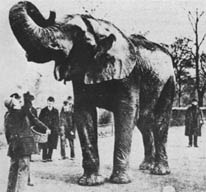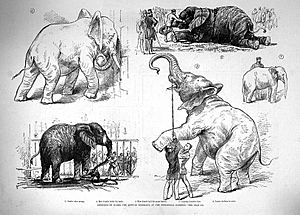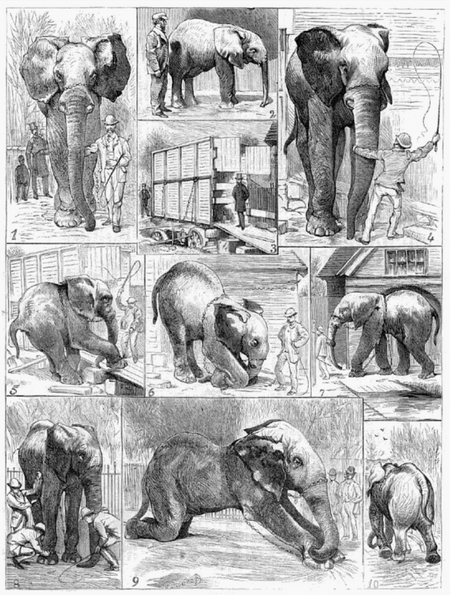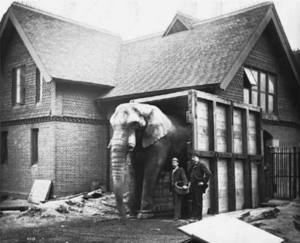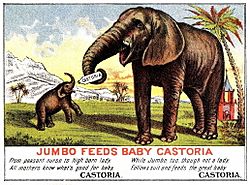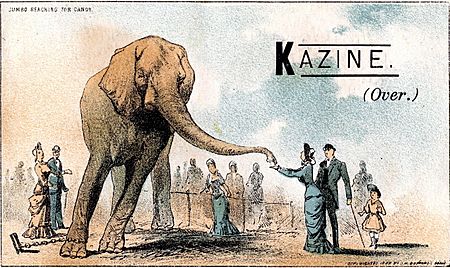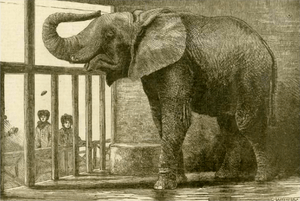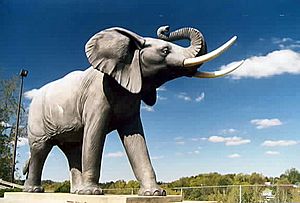Jumbo facts for kids
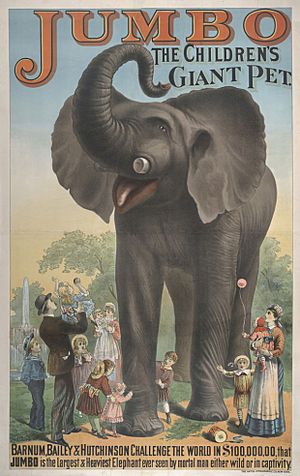
Circus poster
|
|
| Species | African elephant |
|---|---|
| Sex | Male |
| Born | Christmas 1860 East Africa |
| Died | September 15, 1885 (aged 24) St. Thomas, Ontario, Canada |
| Occupation | Zoo and circus attraction |
| Years active | 1862–1885 |
| Owner | Jardin des Plantes London Zoo P. T. Barnum |
| Weight | 12,000 lb (5,400 kg) |
| Height | 12 ft (3.7 m) |
| Named after | Mumbo Jumbo, an African idol |
Jumbo was a famous African elephant. He was born around Christmas 1860 and died on September 15, 1885. Jumbo was the first African elephant to live in modern Europe. He became a huge international animal superstar.
Jumbo was captured in eastern Africa in early 1862. He was first sold to a traveling zoo in Germany. Then, he moved to the Jardin des Plantes in Paris. Later, he was traded to the London Zoo for a rhinoceros.
Jumbo lived at the London Zoo for about 16 years. He grew to be the biggest elephant in captivity. In 1882, the American circus showman P. T. Barnum bought Jumbo. The elephant made his first appearance in the United States on Easter Sunday 1882. This was at Madison Square Garden in New York City. Jumbo toured with Barnum's circus for three years. In September 1885, he died in a train accident in Canada.
Jumbo stayed famous even after his death. His hide was stuffed, and his bones were saved. His stuffed hide and skeleton were shown with Barnum's circus. Later, they went to museums. The hide was destroyed in a fire at Tufts University in 1975. His skeleton was displayed for many years in the American Museum of Natural History in New York City. Over time, people forgot about him, and his skeleton was put away.
Contents
Jumbo's Early Life
No one knows exactly when or where Jumbo was born. In February 1862, a British explorer found Jumbo. This was in a desert camp of elephant hunters. The camp was near the border of eastern Sudan and Eritrea. The hunters caught wild animals to sell to zoos in Europe.
The explorer guessed Jumbo was about 4 feet (120 cm) tall. He probably weighed around 500 pounds (230 kg). Based on his size, Jumbo was about one year old. He was likely born around Christmas 1860.
Jumbo had a very long journey. He walked hundreds of miles with other animals to the Red Sea. At the port of Suakin, the little elephant got on a steamship. He arrived in Trieste, Italy. From Italy, he traveled by train to Dresden, Germany. Then, he was sold to a traveling zoo.
Life in Paris
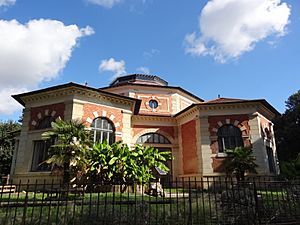
In late 1862, Jumbo was sold to the Jardin des Plantes in Paris. He probably arrived there in late 1862 or early 1863. The French zoo was a bit disappointed. They thought he would be bigger. Jumbo lived in a large building called the Rotunda. He shared it with two Asian elephants, camels, giraffes, and a hippopotamus.
In October 1863, two more baby African elephants arrived. They were named Castor and Pollux. These little elephants played and slept together. Children loved them and called them "the pets of young Paris." Jumbo did not like attention from people. He preferred to stay in his stable. Now, five elephants lived in the Rotunda.
In April 1865, officials found that the living conditions at the Jardin were poor. They decided some elephants should go to other zoos. The London Zoo wanted an African elephant. They traded an Indian rhinoceros and other animals for Jumbo. He was moved to the London Zoo in June 1865.
Jumbo at the London Zoo
Jumbo was very sick when he arrived at the London Zoo. He had not been fed well. His skin was dirty and had to be cleaned. His foot nails were too long, and his feet had sores.
Abraham Bartlett, the zoo's Superintendent, put Jumbo in the care of Matthew "Scotty" Scott. Scotty was very good at understanding animals. Under Scotty's care, Jumbo grew stronger and healthier.
Jumbo became a huge attraction at the London Zoo. Queen Victoria and the Royal Family loved him. Children could ride in a special seat (called a howdah) on his back for a penny. Young Winston Churchill rode on Jumbo. Queen Victoria's children, Prince Leopold and Princess Beatrice, probably did too.
By the time Jumbo was seven, he ate a lot. Every day, he ate 200 pounds (91 kg) of hay. He also ate a barrel of potatoes, two bushels of oats, fifteen loaves of bread, and many onions. He drank several pails of water.
In 1880, Jumbo broke both his tusks by hitting his iron cage doors. He was in pain and stopped eating. He leaned against the walls for support. Bartlett and Scotty had to perform surgery. After the surgery, Jumbo kept his tusks short by rubbing them. They never grew more than a few inches.
By 1882, Jumbo was 12 feet (3.7 m) tall at his shoulder. He weighed over 12,000 pounds (5,400 kg). His trunk was 7 feet (2.1 m) long. It could reach high into the trees. Harper's Weekly magazine said Jumbo was gentle with children. It said he would gently take biscuits and sugar from visitors.
Jumbo is Sold to Barnum
In 1882, Jumbo was the biggest elephant in captivity. Bartlett thought it was best to find a new home for him. One reason was that Jumbo might enter musth. This is a time when male elephants can become violent. Another reason was Jumbo's close bond with Scotty. Bartlett worried Jumbo might become dangerous if Scotty died.
Jumbo sometimes had tantrums at night. He would try to damage the Elephant House. He might have been scared or angry when Scotty went home. He was only calm during the day when Scotty was there or when he gave rides. Jumbo's behavior made Bartlett sure he needed a new home. Years later, scientists studied Jumbo's teeth. They found his molars were growing in a way that likely caused him pain. This was probably why he had tantrums.
Bartlett and the London Zoological Society were happy when P. T. Barnum offered to buy Jumbo for $10,000. Barnum was a famous circus showman from the United States. He knew the huge elephant would make him a lot of money. Barnum wanted Jumbo because he was the biggest elephant in the world. The London Zoological Society agreed to sell Jumbo in just two days.
When the British people found out Jumbo was being sold, they were very angry. Bartlett received many angry letters. Children begged him to keep Jumbo in London. People even tried to stop the sale in court, but Barnum won. The British courts said he legally owned Jumbo.
A large wooden box was built for Jumbo's trip to America. It was made of heavy pine boards and strong oak. It was 14 feet (4.3 m) long, 8 feet (2.4 m) wide, and 12 feet (3.7 m) high. It was big enough for Jumbo to stand, but not to lie down or turn around. The ends had strong iron bars. Jumbo could look out and swing his trunk.
Plans were made to move Jumbo on February 18. But Jumbo would not get into the box. A second try on February 19 also failed. Jumbo lay down in the street. Crowds cheered for Jumbo. He stayed in the street for a week. Bartlett thought Scotty was secretly stopping Jumbo from getting in the box. He told Scotty he would be fired if Jumbo didn't get in. The next day, Scotty got Jumbo to enter the box. Barnum then hired Scotty to keep caring for Jumbo in America.
Jumbomania: A Global Sensation
People all over the world were interested in Jumbo's sale. Souvenirs like Jumbo neckties, fans, and hats were sold in England and America. Jumbo's picture was on thousands of advertisements. Some ads showed Jumbo in funny places, like an opera house or a saloon in the Wild West.
Many products were named after Jumbo. These included potholders, cigars, and even a large sewing machine. Soap, thread, and baking powder also used Jumbo's name. One ad showed Jumbo in leather boots running across a desert.
Jumbo Arrives in America
Jumbo arrived in New York harbor around midnight on Easter Sunday, April 9, 1882. He had been at sea for almost two weeks. A telegram was sent to the London Times to tell the British that Jumbo was safe and healthy. Jumbo's crate was lifted from the ship, the Assyrian Monarch. It was then moved to a smaller boat called Only Son. Jumbo was taken across the Hudson River to the New York docks.
Barnum and his partners, Bailey and Hutchinson, went onto the Only Son with several journalists to see Jumbo. The elephant had traveled well. Barnum was very excited about Jumbo. Everyone was talking about the animal, which meant many tickets would be sold.

Superintendent Hatfield from the Society for the Prevention of Cruelty to Children came aboard. He had heard about Jumbo's bad temper. He wanted to make sure Jumbo was not a danger to children in New York City. Barnum told him Jumbo was "perfectly lamb-like." Hatfield looked at Jumbo and felt that he was indeed a gentle animal.
Hundreds of people had gathered on shore to welcome Jumbo. By late afternoon, the crowd grew to 10,000 noisy onlookers. Jumbo became scared. His crate swayed as it was lifted onto a barge. Three cheers went up from the crowd. By 7:00 pm, Jumbo was on land. His crate was put on a strong wagon.
When the group arrived at Madison Square Garden, Jumbo's crate was too tall for the entrance. He was left on the sidewalk for the night, covered with tarpaulins. In the morning, workers removed the iron bars of the crate. Jumbo was free, but he would not leave the crate. Scotty stood back to let Jumbo take his time. The elephant finally stepped out and went into the building. The floorboards cracked under his huge weight.
When he reached the race track, he knelt and rolled over. Scotty told everyone Jumbo was just resting after his long trip. He finally got up and was taken to his stall. A heavy chain was put around his leg and tied to a stake. He easily pulled the stake from the ground and threw it aside. Meanwhile, the largest crowd in circus history was waiting for the show to start.
Jumbo's Circus Life
Barnum bought Jumbo for $10,000. But Jumbo's total costs were actually $30,000. Barnum later wrote that Jumbo earned back his costs in his first two weeks. This was at the circus in Madison Square Garden. Jumbo did not do tricks. But 20,000 customers each day saw him in the circus zoo. They also saw him in the parade at the start of the show. The London Zoo had sent Jumbo's howdah to America. The great elephant gave rides to circus customers.
Jumbo traveled in comfort when he went on tour each year. He had his own special railway boxcar. Barnum called it "Jumbo's Palace Car." It was red and gold. It had huge double doors in the middle for Jumbo to get in and out easily. Scotty slept in a bunk in a small room near Jumbo's head. Jumbo would never let Scotty close the door to the room. He loved his friend and wanted him nearby always.
In his four years as the main star of Barnum's circus, Jumbo never hurt anyone. Sometimes, though, he tested his strength. He would destroy parts of his winter Elephant House. Jumbo earned $1.5 million in his first year with the circus. About 16 million adults and 4 million children likely saw him at the circus.
In his last years with the circus, Jumbo's health got worse. He could not eat his food well because his teeth were worn out. There was no treatment for this. Jumbo would eventually die from his teeth problems. Barnum made plans to have Jumbo preserved by a taxidermist after his death. He arranged everything while Jumbo was still alive, just in case the elephant died suddenly.
Jumbo's Death
Jumbo was 24 years old when he died on September 15, 1885. He was killed in a train accident. This happened at the rail yards in St. Thomas, Ontario, Canada. He died within minutes of the accident. Neither Barnum nor Bailey was there when it happened.
Taxidermists from Rochester, New York, arrived to take care of his body. Jumbo's death was a big loss for the circus. Barnum even started bankruptcy plans a few days after the tragedy.
After Jumbo's Death
Jumbo's remains were sent to different places in America. His tusks were broken into many pieces in the accident. These pieces were sold as souvenirs. Cornell University bought Jumbo's heart. The great elephant's bones toured America for a few years with the circus. They weighed 2,400 pounds (1,100 kg). Then they were sent to the American Museum of Natural History in New York City. His skeleton was displayed sometimes. But as time passed, children forgot him. The skeleton was put away and was not displayed after 1977.
Jumbo's hide was stuffed in Rochester, New York. The stuffed hide toured with the circus for a few years. Then it was sent to the Barnum Museum of Natural History at Tufts University. It weighed 1,538 pounds (698 kg).
On April 14, 1975, Jumbo's hide was destroyed in a fire at Tufts University. Many other valuable museum pieces were also lost forever.
In 1985, on the 100th anniversary of Jumbo's death, a monument was built for him in St. Thomas. It stands on a hill above the city. Nearby is a bright red caboose, which is a souvenir stand. There is also a museum at the site that shows a model of a small circus.
Jumbo's Legacy
In the United Kingdom, there are statues and other items that remember Jumbo. Even though his hide was destroyed, Jumbo is still the mascot of Tufts University. Pictures of the elephant are seen all over the campus.
A life-sized statue of Jumbo was put up in 1985 in St. Thomas, Ontario. This was to remember the 100th year since his death. It is on Talbot Street on the west side of the city. In 2006, the Jumbo statue was added to the North America Railway Hall of Fame. It was recognized for its local importance in "Railway Art Forms & Events."
Jumbo was also the reason for the nickname of the 19th-century Jumbo Water Tower. This tower is in the town of Colchester in Essex, England.
Lucy the Elephant, a six-story building in Margate City, New Jersey, was designed to look like Jumbo. Built in 1881 by James V. Lafferty, Lucy is the oldest surviving roadside tourist attraction in America. It is also a National Historic Landmark. Lafferty also made other Jumbo-shaped buildings, like Elephantine Colossus on Coney Island.
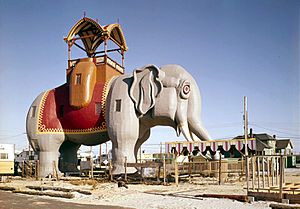
Because of Jumbo's huge size, scientists once thought he was a different kind of elephant. He was the largest elephant ever known. Later, they learned that Jumbo was not a separate species. He was just a very large example of a known species.
Jumbo's greatest gift was the joy he brought to millions of people. His name itself might be his biggest legacy. Before this big elephant, the word 'Jumbo' was not used in English. Now, the word means anything that is huge. People will always remember Jumbo because of this word.
Images for kids
-
Jumbo and Matthew Scott giving rides to children in London Zoo
-
An 1889 photograph of Jumbo at Barnum Hall, taxidermy by Carl Akeley
See also
 In Spanish: Jumbo (elefante) para niños
In Spanish: Jumbo (elefante) para niños


